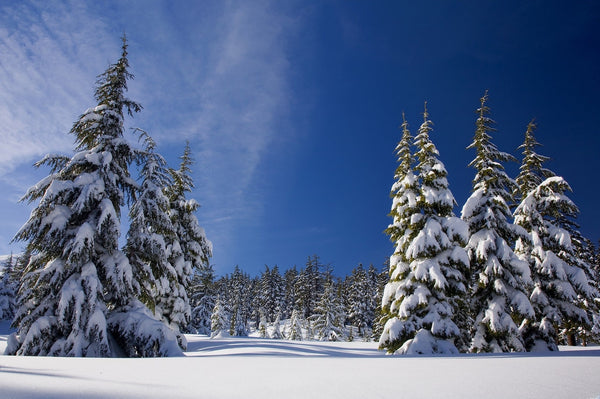As temperatures drop and it starts to frost in the fall, we watch pretty deciduous trees display stunning fall colors before their leaves drop. However, evergreens keep their amazing color year-round and continue their normal processes, just at a slower rate.
So, winter plant protection during the harsh winter season is important, especially while your evergreens become established. Here are a few simple tips to keep yours happy and healthy!
1. Determine Growing Zones for Your Evergreens
The USDA Plant Hardiness Zone Map displays different zones around the country based on the average lowest winter temperature in the area. Most of the country is divided into growing zones 3 through 11, with zone 3 being the coldest.
Live on the border between two zones and wonder if your plant will survive the winter? Just look at the average low temperatures for your region. If it gets too cold for your plant’s recommended growing zone, don't push it.
For example, the Norway Spruce is an evergreen that can survive in extra cold temperatures. Because the Norway Spruce is recommended for growing zones 2 through 5 (but not recommended for the south), it’s super hardy...however, it's important to ensure you don't take varieties outside their recommended growing zones. You can provide extra winter protection for those on the cusp of two zones, but keep an extra eye on these trees.
2. Water Trees During Winter
If you aren’t getting much rain during the fall, give your trees some supplemental water but don’t overwater them. Once the ground freezes, water won’t be able to get down to the roots, so it’s important for winter plant protection that trees get enough moisture in the autumn before the ground freezes. Placing a layer of mulch around the bases of your trees will help their soil retain moisture as well.
Another factor to watch: Windburn. Windburn is the process by which cold arctic winds blow against an evergreen’s foliage, causing them to lose water. As a result, the foliage turns brown and dies. This usually occurs in the spring when it’s starting to warm up but winds are still cold, and the ground is still frozen. This is when trees start to enter the growing season and need more water to thrive.
Winter plant protection for windburn involves wrapping your trees in burlap (allow the tops of trees to stick out). You can also set up a burlap screen in front of your tree in the wind’s direction. Generally, windburn only turns tree needles brown on the side where the wind is hitting. If one tree completely turns brown, it’s more likely that it has a disease or pests.
For further winter plant protection and health, any browned or dead areas of the tree should be pruned back in the spring. New foliage will grow to fill in any gaps left by removing dead branches and foliage.
3. Recommended Winter Protection for Evergreens
One factor that is missed easily is fluctuating temperatures. When temperatures drop during the night and warm up during the day, trees’ temperatures fluctuate at a too-fast rate. As they expand and contract, their trunks can crack. The cracks are known as frost cracks. To prevent frost cracks for your winter plant protection, spread a layer of insulating material, like mulch, around the roots. The mulch will help your trees heat up and cool down over time instead of at a rapid rate.
Furthermore, snow can be quite heavy as it weighs trees down. Sometimes tree branches even snap under the pressure. If you have weak branches, tie them together so that they’re facing upwards, around the trunk of your tree. If your tree has multiple leaders, you can tie them together as well.
And when the bright sun bounces off the snow, it can hit evergreens and burn them. As a result, their needles will turn brown or yellow.
Plus, if a lot of warm sun heats up your trees and they start photosynthesizing at a quicker rate, only to freeze once more, the needles may become discolored. These processes are called sunscald or sunburn. To prevent sunscald, create a burlap barrier to block harsh sunlight from hitting the sides of your trees, or wrap it in burlap. The most sun comes from the East and South, so those are the best directions for your barriers to face.

4. Can Evergreens Handle Salt?
Salt used to melt snow results in high salinity levels in runoff, which can be absorbed by your tree. As a result, the needles on your trees can turn brown and die back.
When trees are affected by salts, the parts exposed to the salt turns brown, rather than the entire tree. To avoid salt damage for winter plant protection, avoid placing your trees near heavily salted roads. In addition, make sure that your tree doesn’t sit in an area that receives a lot of runoff from salted areas. If you’re concerned that your area is too salty for an evergreen, you can choose a salt tolerant variety, like the Colorado Blue Spruce.
5. Keeping Animals Off Evergreen Trees
When food is scarce, animals will eat bark and maybe even nibble on the roots. The main bark-chewing culprits are bunnies and mice. Keep them away by building a 2-foot mesh wire fence around the base of your tree. You can also place a fake owl and fake snakes around your plants.
Furthermore, you can keep deer away by placing a 4-foot mesh wire fence around your trees. And it’s very important to check on your fences every few days to make sure that animals haven’t become trapped inside.
Also, there are all-natural pest repellents that cause plants to smell bad and taste undesirable to critters. Or you can purchase evergreens that deer and other animals don’t enjoy, like the American Holly or the Thuja Green Giant.





